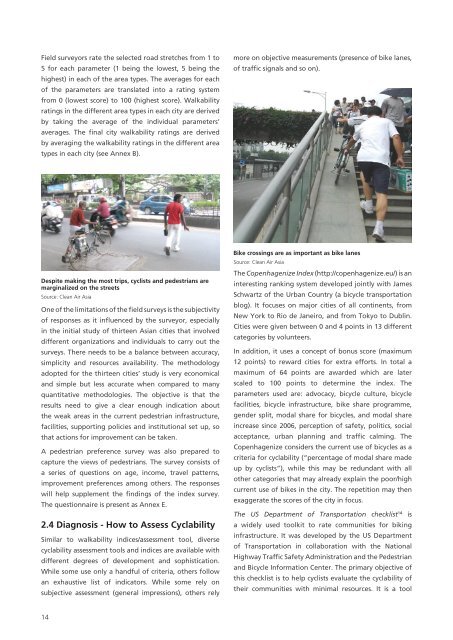Promoting Non-motorised Transport in Asian Cities
Shakti Sustainable Energy Foundation conducted a study to assess the viability of promoting non-motorised transport in Asian cities. As part of the study, they undertook a project – Nehru Place Placemaking. See more at: http://shaktifoundation.in/report/promoting-non-motorised-transport-asian-cities-policymakers-toolbox/
Shakti Sustainable Energy Foundation conducted a study to assess the viability of promoting non-motorised transport in Asian cities. As part of the study, they undertook a project – Nehru Place Placemaking. See more at: http://shaktifoundation.in/report/promoting-non-motorised-transport-asian-cities-policymakers-toolbox/
You also want an ePaper? Increase the reach of your titles
YUMPU automatically turns print PDFs into web optimized ePapers that Google loves.
Field surveyors rate the selected road stretches from 1 to<br />
5 for each parameter (1 be<strong>in</strong>g the lowest, 5 be<strong>in</strong>g the<br />
highest) <strong>in</strong> each of the area types. The averages for each<br />
of the parameters are translated <strong>in</strong>to a rat<strong>in</strong>g system<br />
from 0 (lowest score) to 100 (highest score). Walkability<br />
rat<strong>in</strong>gs <strong>in</strong> the different area types <strong>in</strong> each city are derived<br />
by tak<strong>in</strong>g the average of the <strong>in</strong>dividual parameters’<br />
averages. The f<strong>in</strong>al city walkability rat<strong>in</strong>gs are derived<br />
by averag<strong>in</strong>g the walkability rat<strong>in</strong>gs <strong>in</strong> the different area<br />
types <strong>in</strong> each city (see Annex B).<br />
more on objective measurements (presence of bike lanes,<br />
of traffic signals and so on).<br />
Despite mak<strong>in</strong>g the most trips, cyclists and pedestrians are<br />
marg<strong>in</strong>alized on the streets<br />
Source: Clean Air Asia<br />
One of the limitations of the field surveys is the subjectivity<br />
of responses as it <strong>in</strong>fluenced by the surveyor, especially<br />
<strong>in</strong> the <strong>in</strong>itial study of thirteen <strong>Asian</strong> cities that <strong>in</strong>volved<br />
different organizations and <strong>in</strong>dividuals to carry out the<br />
surveys. There needs to be a balance between accuracy,<br />
simplicity and resources availability. The methodology<br />
adopted for the thirteen cities’ study is very economical<br />
and simple but less accurate when compared to many<br />
quantitative methodologies. The objective is that the<br />
results need to give a clear enough <strong>in</strong>dication about<br />
the weak areas <strong>in</strong> the current pedestrian <strong>in</strong>frastructure,<br />
facilities, support<strong>in</strong>g policies and <strong>in</strong>stitutional set up, so<br />
that actions for improvement can be taken.<br />
A pedestrian preference survey was also prepared to<br />
capture the views of pedestrians. The survey consists of<br />
a series of questions on age, <strong>in</strong>come, travel patterns,<br />
improvement preferences among others. The responses<br />
will help supplement the f<strong>in</strong>d<strong>in</strong>gs of the <strong>in</strong>dex survey.<br />
The questionnaire is present as Annex E.<br />
2.4 Diagnosis - How to Assess Cyclability<br />
Similar to walkability <strong>in</strong>dices/assessment tool, diverse<br />
cyclability assessment tools and <strong>in</strong>dices are available with<br />
different degrees of development and sophistication.<br />
While some use only a handful of criteria, others follow<br />
an exhaustive list of <strong>in</strong>dicators. While some rely on<br />
subjective assessment (general impressions), others rely<br />
Bike cross<strong>in</strong>gs are as important as bike lanes<br />
Source: Clean Air Asia<br />
The Copenhagenize Index (http://copenhagenize.eu/) is an<br />
<strong>in</strong>terest<strong>in</strong>g rank<strong>in</strong>g system developed jo<strong>in</strong>tly with James<br />
Schwartz of the Urban Country (a bicycle transportation<br />
blog). It focuses on major cities of all cont<strong>in</strong>ents, from<br />
New York to Rio de Janeiro, and from Tokyo to Dubl<strong>in</strong>.<br />
<strong>Cities</strong> were given between 0 and 4 po<strong>in</strong>ts <strong>in</strong> 13 different<br />
categories by volunteers.<br />
In addition, it uses a concept of bonus score (maximum<br />
12 po<strong>in</strong>ts) to reward cities for extra efforts. In total a<br />
maximum of 64 po<strong>in</strong>ts are awarded which are later<br />
scaled to 100 po<strong>in</strong>ts to determ<strong>in</strong>e the <strong>in</strong>dex. The<br />
parameters used are: advocacy, bicycle culture, bicycle<br />
facilities, bicycle <strong>in</strong>frastructure, bike share programme,<br />
gender split, modal share for bicycles, and modal share<br />
<strong>in</strong>crease s<strong>in</strong>ce 2006, perception of safety, politics, social<br />
acceptance, urban plann<strong>in</strong>g and traffic calm<strong>in</strong>g. The<br />
Copenhagenize considers the current use of bicycles as a<br />
criteria for cyclability (“percentage of modal share made<br />
up by cyclists”), while this may be redundant with all<br />
other categories that may already expla<strong>in</strong> the poor/high<br />
current use of bikes <strong>in</strong> the city. The repetition may then<br />
exaggerate the scores of the city <strong>in</strong> focus.<br />
The US Department of <strong>Transport</strong>ation checklist 14 is<br />
a widely used toolkit to rate communities for bik<strong>in</strong>g<br />
<strong>in</strong>frastructure. It was developed by the US Department<br />
of <strong>Transport</strong>ation <strong>in</strong> collaboration with the National<br />
Highway Traffic Safety Adm<strong>in</strong>istration and the Pedestrian<br />
and Bicycle Information Center. The primary objective of<br />
this checklist is to help cyclists evaluate the cyclability of<br />
their communities with m<strong>in</strong>imal resources. It is a tool<br />
14

















